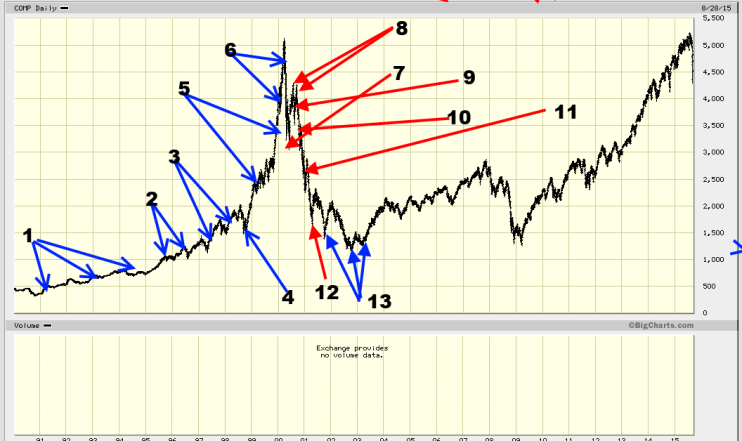
How to invest in stocks: The playing field is not level
We covered this topic several years ago, but we used a chart of the now defunct company, CMGI. Hence, decided to come out with this new update. In this example, we will use the NASDAQ. The chart below is a graphic representation of the thought process that the average investors experience when trying to get into any investment. The same concept applies to any stock, index or any market. Hence GOOG, AAPL, WMT, IBM, NTES, SOHU, MSFT, etc. are all bound by the same rules.
Most investors jump into the markets without taking the time to do any legwork. They assume by reading a few books, listening to the talking heads on CNBC and following a few so-called experts, they are ready to take on the stock market. The market is a mighty beast that has a win ratio more than 90%. Only 10% of investors can consistently claim to make walk away with gains.
Get a grip of your emotions before you invest in the markets
The ordinary individual regardless of their background is almost always on the receiving end of the stick when it comes to investing. The reason for this predicament is predicated upon the fact that the typical person leaps before he thinks. In other words, the decision-making process is driven by their emotional state. Emotions and investing are like oil and water, no matter how hard you try they will never mix. Emotional traders are bankrupt traders. Throw emotions out of the window; kill them on sight.
The solution to winning in the markets
The solution to this dilemma is dangerously simple. In fact, it is so simple that its simplicity is what makes it so hard for the multitude to implement. As we stated emotions should be shot on sight; the acronym shoot and ask questions later is highly applicable in this instance. Emotions should never be allowed to have a seat at the discussion table. To be a successful investor one needs to do the opposite of their useless emotions are dictating. There is simply no place for any extreme deviation from the norm when it comes to investing, and euphoria and panic are extreme deviations from the norm.

How to invest in stocks: Observation
- This stock is going nowhere; it is hardly moving, and the fundamentals are weak. I need to find a high flyer one that can move and not this laggard.
- Pure luck, the fools who jumped in, will regret it. This is a false breakout. This stock is going drop to new lows. I am not going to waste my hard-earned money on this junk.
- Holy smokes, the stock is still going up. Earnings are terrible, long-term fundamentals are not great, and the technical outlook is far from perfect. I think I will pass, as I am sure, it’s going to crash and burn. I am convinced is the secret code word for knowing nothing. Moreover, it is impossible to use technical indicators actually if you are looking through an emotional lens.
- Thank goodness I did not buy; I knew it was going to crash. Instead of focusing on the fact that the stock is letting out some steam and building momentum for the next leg up, the mass mindset sees’s only what it wants to see. Governed by useless emotions, it is unable to recognize the opportunity, as it has an almost unstoppable affinity for embracing the opposite. In this instance, the market did pull back, but a close examination reveals that the pullback is just the market letting out some well-deserved steam. In fact, the market ends up putting in a higher low, which is a very bullish development. The horde has an impeccable record at jumping into an investment when euphoria is the air, and out of them when blood is flowing through the streets.
- Wait a minute, what’s going on here? The market was supposed to crash. Maybe I made a mistake in not buying. Well, it’s not too late; the picture looks good, and analysts are upbeat about earnings, so I think it is still not too late to get in. The masses need reassurances that all is well, but reassurances come only towards the end of the game. Finally, this chap musters the courage to jump in. Wow, it went up, great; I’m making money.
- I was smart to wait until things improved before getting in; it looks like the markets are going to take off……….. Let me call all my friends and tell them to jump in before it’s too late. Remember when everyone is happy, it is usually time to hit the road.
- What is going on; why is the market dropping? It’s only a pullback; I am not going to fall for this game again (look at reason number 4). It’s time to average down and load up.
- There you go; I knew it was going to turn around. I should have put more into in the market. Next time, I will load up as this is the way to make money. Now the secret desire to lose syndrome kicks in. This guy is trapped in a euphoric mood and fails to recognise that the market did not trade to new highs. It put in a lower high, which should have construed as a warning signal. The mass mindset as we stated before only detects what it wants to spot. For this guy, the only thing that matter is that he made some extra money.
- It’s going down again. Opportunity is knocking, and it’s time to load up. Earnings continue to improve; all the analysts on CNBC are bullish, and therefore, it must be a good time to put even more money into the markets. It’s time to back the truck and load up. I need to call everyone and tell them not to miss this opportunity. When you are sure about something, it’s better to sit out and wait. Overconfidence is a sure sign that you are missing something.
- The market is hit with a dose of bad news and pulls back very strongly. Ah, this is just a temporary development. The market will recoup and trend higher. I am going to buy more and average down. Gamblers always think of averaging down and hardly think of averaging upwards. All of a sudden, this chap has become an expert on the timing the markets. Blind faith is one of the main ingredients the masses seem to have an endless amount of. If you trade the markets on faith, there is only one thing waiting for you at the end of the cycle; loss and despair.
- Now panic and dread start to set in. He questions himself. Did I do the right thing by buying more? Perhaps, I should have sold when I was in the black and booked those small gains I had. Maybe it is time to bail out and cut my losses. Things don’t look so good now. You know what; let me hold for a bit longer, maybe things could suddenly change. The outlook has to change; things were great, and how could they change so suddenly. The worst is over; it has to go up.
- Damn it; the market is dead. I am getting the hell out of the stock market. I should have never jumped in. I will never invest in the stock market. Ironically, around this time is when the markets start to give hints that a bottom is not too far in the marking. This individual is a bailing out when, in fact, he should be holding on. He is selling close to the bottom and allowing fear and anguish to direct his actions, just as he allowed joy to guide him into the markets.
- The market is going through a slow bottoming phase. Once this phase ends a new uptrend will begin. This guy bailed out very close to the bottom. At this point, of the game, he should have considered holding onto the positions, as he had taken on an inordinate amount of pain hoping for a recovery. Instead, he opts for even more pain and suffering by selling very close to the bottom.
How to invest in stocks: Conclusion
It is imperative that you understand emotions can and will only push away from the right path. Their sole function is to confuse you and make the already complex job of investing even more complex. In other words, you are almost guaranteed to lose if emotions are the main driving force when it comes to investing in the markets.
“Misery loves company, but stupidity simply demands it.” All emotions are based on perceptions. Perception is based on what one assumes to be real. What you deem to be real or illusory could change dramatically depending on whether you are calm or agitated.
The key ingredient to mastering mass psychology is to have control over your emotions. Trying to identify the exact top or bottom is an exercise in futility best reserved for imbeciles with plenty of time on their hands with an inordinate appetite for pain.
The objective should be to distinguish subtle telltale signs that point out when a market is topping or bottoming. Once this identified the practical move is to open a long or short position depending on what you have discerned, even though you might end up opening position significantly earlier than the masses; feel content when you are not in sync with the masses and apprehensive when you are.
The Best Investing Books
I have yet to read one technical analysis book that I was not inclined to throw into the trash can. Over the years, I looked at many books that covered this topic, and have found nothing of value out there. There are some books, with great pictures but other than that they contain nothing of value. Almost every author seems to want to go out of his or her way to make the subject look complex. Secondly, half of the studies they mention are useless, and I am being conservative. Here are some simple examples, Head and shoulders pattern, rising wedge, bull flag, cup and handle, and a host of other nonsense.
Let’s also not forget about the silly omens these books like to brag about, like the almighty useless death cross or the infamous Hindenburg omen, etc.. You would be much better served if you can master the art of drawing a simple trend line.
Mass Psychology
Before we put out a list of the best investing books to read, we think the topic of Mass psychology warrants a mention. Understanding the basics of Mass Psychology could go a long way in improving your investment journey. Here is a brief excerpt on the topic:
Mass psychology is the study of group behaviour; the mass mindset draws comfort when it does not go against the views held by the majority. For example, an investor feels comfortable buying biotech stocks because the crowd thinks it’s a good buy. In other words, they are acting like lemmings; they are following the herd mindset. In the markets teamwork does not pay; when the masses are euphoric, it is time to head for the exits and vice versa.
The astute investor purchases when the crowd panics and sells when the mob is jumping up with joy. The phrase to keep in mind is the following ” buy when there is blood in the streets and sell when the masses are ecstatic“. This is the only way you can buy low and sell high with little to no stress. The masses refuse to use history as a guide and in failing to do so they are doomed to repeat it again.
Published courtesy of the Tactical Investor
